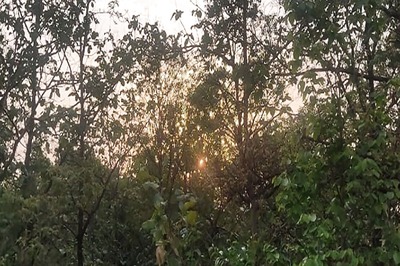
views
The ‘fractured’ relationship between Assam and its neighbouring states over territory once again took a violent turn when police forces and locals of Assam and Mizoram clashed on Monday, resulting in the death of at least six Assam police personnel with over 40 others injured.
On July 26 morning, just days after Union Home Minister Amit Shah met all the chief ministers of the northeastern states and discussed prolonged border disputes in Shillong, Meghalaya, violence erupted in Lailapur in Cachar district, some 355 kms away from Guwahati.
Assam shares a 164 km-long (about 101 miles) border with Mizoram and both states contest its demarcation. Three districts in Assam—Cachar, Hailakandi and Karimganj—share borders with Mizoram. However, the boundary dispute between the two states is not new. It is a 146-year-old dispute that dates back to the British rule in India.
A 146-year-old Border Dispute
In 1875, British had determined the boundary between Assam’s Cachar and Mizoram, which was then known as Lushai Hills. Both the areas were parts of Greater Assam then. During that time, the northeast region comprised three states—Manipur, Tripura and Assam. Mizoram, Meghalaya, Nagaland and Arunachal Pradesh were all part of Greater Assam.
Disagreements regarding the interstate borders started when Mizoram declared that it does not accept the present boundary with Assam and that the inner line of the Inner Line Reserved Forest as described in the 1875 notification under the Bengal Eastern Frontier Regulation (BEFR) of 1873 should be the basis for demarcation of the border and not the 1933 boundary demarcation, which Assam wants enforced.
ALSO READ | Unsettled Borders with China, Assam-Mizoram Police Clash Is the Last Thing India Needs
In 1933, the British demarcated the northeastern region into separate districts based on cultural, linguistic and tribal lines. This led to a new boundary separating Lushai Hills (Mizoram), Cachar (Assam) and present Manipur. As part of this trifurcation, some parts of Lushai Hills also went to Manipur.
Following Independence, Mizoram was carved out of Assam in 1972 as a Union Territory (UT) and later granted statehood on February 20, 1987. But the boundary between these states remained a matter of dispute. Mizoram wanted its borders with Assam to be determined according to the 1875 agreement.
According to Mizoram Chief Minister Zoramthanga, the 1933 demarcation was faulty and not done in proper consultation with Mizo counterparts, with many of the Mizo-speaking districts going to Assam.
Assam Chief Minister Himanta Biswa Sarma, while visiting the injured on Tuesday, said, “Why would we follow the 1875 map? In that case, today’s Mizoram was all part of Assam but we never claimed that.”
Illegal Immigration a Factor?
The Mizoram-based Joint Action Committee (JAC) on Inner Line Forest Reserve Demand has said that the administration of the 509 sq miles of the Inner Line Reserved Forest, which is currently being administered by the forest department of the Assam government, be handed over to the forest department of Mizoram.
The JAC along with various political parties and NGOs in a memorandum submitted to Prime Minister Narendra Modi in 2018 had said that areas such as Cachar Zion, Lala Bazar and Bhanga Bazar, where large numbers of Mizo people live, were excluded from Mizoram in the demarcation of 1933.
David L., a resident of Vairengte village adjoining Assam’s Lailapur said, “Our forefathers have ruled these areas for centuries and still there are multiple villages of Mizo people inside Assam’s territory. Though there were confrontations earlier too, the situation started to deteriorate when Assam began to allow illegal settlements of Bangladeshi infiltrators.”
The JAC leaders in a press statement said, “Our present issue is not an issue between the Assamese and Mizo people, rather, our present issue is about the settlement of illegal Bangladeshi immigrants.”
ALSO READ | To Integrate Northeast with Rest of India, Improving Air Links Must be Top Priority
Assam, on the other hand, denied the allegations that illegal Bangladeshi immigrants were settling in the forest areas of Lailapur. “Even if the chief minister builds a house in the forest, it will be evicted as per law. Then how there can be any settlement of Bangaldeshis there? Mizoram government has received wrong information,” said the Assam chief minister.
In 2019, the two states agreed to maintain a status quo with no man’s land in the disputed area. However, according to villagers of Lailapur, the aggression from Mizoram side has become rampant. “Despite living together for years, we have seen heavy aggression from Mizoram side over the last couple of years. They used explosives to bomb school buildings last year and now they shot dead Assam policemen. We will not allow such nuisance and block the highways to Mizoram,” threatened Bimal Purkayastha, a resident of Lailapur.
Earlier, responding to JAC’s memorandum, the Centre had asked the chief secretaries of Assam and Mizoram as well as the Surveyor General of India for their views and comments on the matter; the Mizoram government has failed to send its view on the matter despite repeated reminders. Finally, the Mizoram government constituted a boundary commission to deal with the demarcation of the state’s border with Assam on July 23, three days before the violent clash.
Assam’s Border Disputes with Other States
But its’ not only Mizoram with whom Assam shares a bitter relationship when it comes to the border issue.
The tensions along Assam’s borders can be gauged from the numbers: some 127 cases of inter-state border disputes were registered by Assam Police since 2016. Besides the registered number of cases, hundreds of other inter-state border disputes were also reported. According to the numbers submitted before the Assam Assembly during the Budget session, at least 209 incidents of border disputes were reported in the state during the time period.
Assam has the highest numbers of border disputes with Nagaland—99 since 2016; of them, only 52 were registered. Assam and Nagaland share a 500-km boundary. Violent conflicts, some even leading to deaths, have taken place sporadically since 1965.
In May, few suspected Nagaland-based miscreants opened fire at former Congress legislator Rupjyoti Kurmi and a team of journalists who were visiting Assam-Nagaland border in Jorhat district to inspect a border dispute incident. The politician and others had to flee. No arrest has been made in the case, yet.
Similarly, 27 cases of border disputes with Arunachal Pradesh were reported during the period. And, at least 42 such disputes with Mizoram were registered. With Meghalaya too, some 40 incidents of border disputes have been reported since 2016.
“We have cases ongoing on border disputes with Nagaland in the Supreme Court. We are hopeful that the boundary disputes with Meghalaya can also be settled amicably. But boundary dispute with Mizoram is in a very fragile state,” Sarma added.
With Meghalaya, Assam shares an 884 km-long boundary. There has been a series of recent flare-ups between Assam and Meghalaya too. The Meghalaya government claims it has 12 areas of dispute with Assam.
Following a discussion between Assam and Meghalaya on border disputes last week, the Meghalaya government on Monday decided to form three regional committees. After consultation with different stakeholders in the disputed areas, these committees will submit reports.
The author is an independent Assam-based journalist who covers the Northeast. The views expressed in this article are those of the author and do not represent the stand of this publication.
Read all the Latest News, Breaking News and Coronavirus News here.




















Comments
0 comment